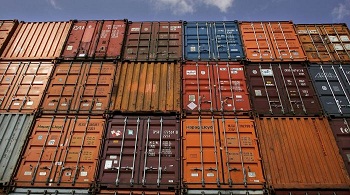September is marked by a new round of tariffs on Chinese imports, which went into effect Sunday. In the latest escalation of the trade war with China, the Trump administration has slapped a 15% tariff on $112bn worth of Chinese goods, something consumers can expect to feel when buying everything from milk to diapers to some China-manufactured tech products like the Apple Watch.
The United States is the world’s largest importing country, with $2.6tn, followed by China with $2.1tn. However, the European Union is, collectively, the world’s largest importer, sending $6.5tn on imports.
As the trade war between the world’s two largest importers (the US and China) carries on, it’s yet to be seen how much of an impact it will have on these countries’ economies.
According to a report from Bloomberg Economics, ongoing uncertainty in the world economy generated by the US-China trade war has more than doubled the financial impact of the Trump administration’s tariffs, coming in at a $585bn hit to global GDP.
The World Trade Organisation (WTO) calculated that between October 16, 2018 and May 15, 2019, there were 20 new restrictions introduced between the world’s most powerful economies, covering trade worth $335.9bn.
This was the second largest spike on record, behind only the preceding period when $480bn worth of trade was affected by new protectionist measures. This means that since the trade war first started in earnest in July 2018, $815.9bn worth of trade has been affected by such measures.
The WTO has been tracking and quantifying “import restrictive measures” since May 2012, and the latest figure is 3.5 times higher than the initial average.
In Egypt’s case, trade deficit declined to $3.34bn in May 2019 compared with $4.42bn in May of 2018, marking a drop of 24.6%, according to the Central Agency for Public Mobilization and Statistics.
Egypt’s imports went down by 14.8% to reach $6.01bn dollars during May 2019, compared to $7.06bn in May 2018.
When it comes to exports, China is still, by far, the largest exporter in the world. The country exported a total of $2.5tn worth of goods in 2018, beating the US by about $800bn.
The largest US export industries include food and beverage, crude oil, civilian aircraft, auto parts, and industrial machines. China’s top exports include machinery, technology, furniture, plastics, and vehicles.
Collectively, the European Union has the largest export industry — exporting $6.5tn worth of goods in 2018. Furthermore, the top three countries combined (China, the US, and Germany) exported more than the next seven countries combined.
The US and China are part of an ongoing trade war, which could significantly affect the world export industry.
Moreover, the potential impact of the US and China trade war on the global economy could reach other countries that rely on these countries as their major trade partners.
The heart of the matter is Germany, Europe’s largest economy and a key trade partner of both the US and China.
Exports amount to almost half the German economy — 47%, according to the World Bank — as its companies play a dominant role in global markets for luxury autos and complex industrial machinery. Supply chains from Germany extend into neighbouring eurozone countries as well. Thus, Germany remains more vulnerable than less open economies such as Portugal or France to a slowdown in global trade in goods and services. Ironically, trade between Germany and the US and between Germany and China is holding up pretty well. It’s mainly the uncertainty about the outcome of the clash between US and China.
In Egypt’s case, exports increased by 1.6% in May 2019 recording $2.68bn compared with $2.64bn in the same month last year, the CAPMAS added in its monthly bulletin.





